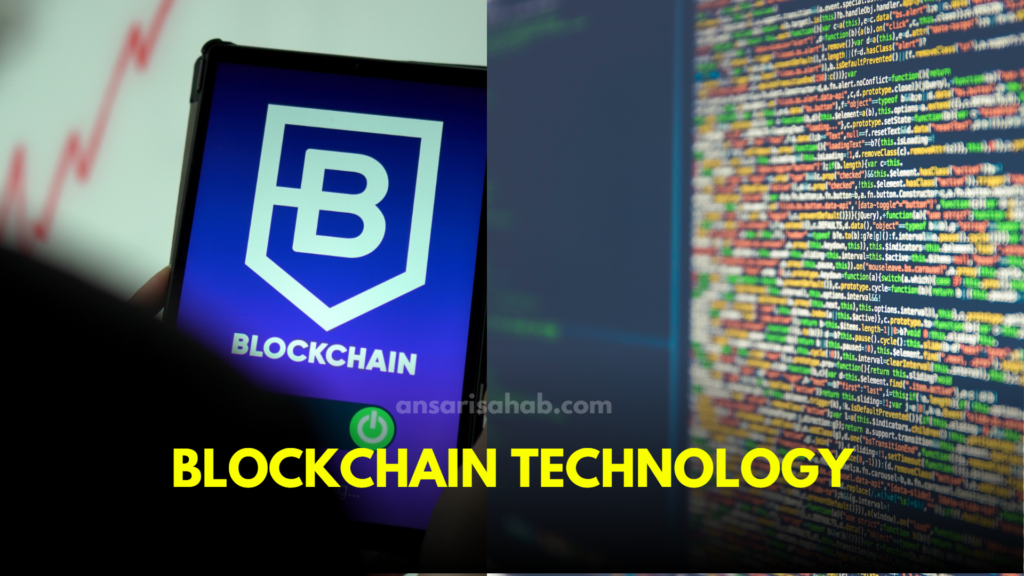
Blockchain technology is the underlying technology behind cryptocurrencies, but it has many other potential applications as well. Blockchain is a distributed ledger system that allows for secure, transparent, and tamper-proof transactions.
In this blog post, we will take a deep dive into blockchain technology and explore its various components, applications, and benefits.
What is Blockchain Technology?
Blockchain technology is a distributed ledger system that allows for secure, transparent, and tamper-proof transactions. A distributed ledger is a database that is shared across multiple computers. This makes it very difficult to hack or tamper with the data, as any changes would need to be made on all of the computers in the network.
Blockchain technology uses cryptography to secure the data and to ensure the integrity of the transactions. Cryptography is a way of encoding data so that it can only be read by authorized users.
Distributed ledger: A distributed ledger is a database that is shared across multiple computers. This means that there is no single central authority that controls the ledger. Instead, the ledger is maintained by a network of computers. This makes it very difficult to hack or tamper with the data, as any changes would need to be made on all of the computers in the network.
Cryptography: Blockchain technology uses cryptography to secure the data and to ensure the integrity of the transactions. Cryptography is a way of encoding data so that it can only be read by authorized users.
One of the key cryptographic techniques used in blockchain technology is hashing. Hashing is a process of converting data into a unique identifier. This identifier is called a hash. Hashes are used to link the blocks together in a blockchain and to verify the integrity of the transactions.
Another key cryptographic technique used in blockchain technology is digital signatures. Digital signatures are used to authenticate transactions and to prevent fraud. A digital signature is a unique identifier that is created by the sender of a transaction. The digital signature is then attached to the transaction and verified by the recipient of the transaction.
Components of Blockchain Technology
Blockchain technology consists of the following components:
Blocks
Blocks are the basic building blocks of a blockchain. Each block contains a set of transactions and a timestamp. The blocks are linked together in a chronological order to form the blockchain.
The timestamp is a unique identifier for the block and it helps to ensure that the blocks are added to the blockchain in the correct order. The transactions in a block are grouped together and then encrypted. This encryption helps to protect the transactions from being tampered with.
Once a block is full of transactions, it is closed and a new block is created. The new block contains the hash of the previous block. This hash is a unique identifier for the previous block and it helps to link the blocks together in a chain.
Nodes
Nodes are the computers that are part of the blockchain network. Each node has a copy of the blockchain and is responsible for verifying and adding new blocks to the chain.
When a new block is created, it is broadcast to all of the nodes in the network. The nodes then verify the block and add it to their own copy of the blockchain. If a node cannot verify the block, it will reject it.
Once a block is verified by a majority of the nodes in the network, it is added to the blockchain. This process is called consensus.
Read Also: Crypto vs. Traditional Investments: Where Should You Put Your Money?
Cryptography
Cryptography is used to secure the data on the blockchain and to ensure the integrity of the transactions. The Cryptography is a way of encoding data so that it can only be read by authorized users.
Blockchain technology uses a variety of cryptographic techniques, including:
- Hashing: Hashing is a process of converting data into a unique identifier. This identifier is called a hash. Hashes are used to link the blocks together in a blockchain and to verify the integrity of the transactions.
- Digital signatures: Digital signatures are used to authenticate transactions and to prevent fraud. A digital signature is a unique identifier that is created by the sender of a transaction. The digital signature is then attached to the transaction and verified by the recipient of the transaction.
- Public key cryptography: Public key cryptography is a type of cryptography that uses two keys: a public key and a private key. The public key is used to encrypt data and the private key is used to decrypt data. Public key cryptography is used to verify the identity of the sender and recipient of a transaction.
Consensus mechanism
The consensus mechanism is the algorithm that is used by the nodes to agree on the state of the blockchain. There are a variety of different consensus mechanisms, including:
- Proof-of-work: Proof-of-work is a consensus mechanism that requires nodes to solve a complex mathematical problem in order to add a new block to the blockchain. This process is called mining.
- Proof-of-stake: Proof-of-stake is a consensus mechanism that requires nodes to stake a certain amount of cryptocurrency in order to be eligible to add a new block to the blockchain.
- Delegated proof-of-stake: Delegated proof-of-stake is a consensus mechanism that allows users to delegate their stake to other users. The users who are delegated stake are called validators. The validators are then responsible for verifying and adding new blocks to the blockchain.
How Blockchain Technology Works
Blockchain technology works by recording transactions in blocks. Each block is verified by the nodes in the network and then added to the blockchain. Once a block is added to the blockchain, it cannot be changed or deleted.
Here is a step-by-step explanation of how blockchain technology works:
- A user initiates a transaction. The transaction can be anything from sending cryptocurrency to another user to voting in an election.
- The transaction is broadcast to all of the nodes in the network.
- The nodes verify the transaction and add it to their own copy of the blockchain.
- Once a block is full of transactions, it is closed and a new block is created.
- The new block contains the hash of the previous block. This hash is a unique identifier for the previous block and it helps to link the blocks together in a chain.
- The new block is broadcast to all of the nodes in the network.
- The nodes verify the new block and add it to their own copy of the blockchain.
- Once a block is verified by a majority of the nodes in the network, it is added to the blockchain. This process is called consensus.
Once a block is added to the blockchain, it cannot be changed or deleted. This is because the blocks are linked together in a chain and each block contains the hash of the previous block. If someone were to try to change a block, they would need to change all of the subsequent blocks in the chain. This would be very difficult to do, as it would require the cooperation of a majority of the nodes in the network.
Read Also: The Future of Cryptocurrency: Trends and Predictions for 2023
Applications of Blockchain Technology
Blockchain technology has the potential to revolutionize many industries. Here are some of the potential applications of blockchain technology:
- Cryptocurrencies: Blockchain technology is used to power cryptocurrencies such as Bitcoin and Ethereum. Cryptocurrencies are digital or virtual tokens that use cryptography to secure their transactions and to control the creation of new units.
- Financial services: Blockchain technology can be used to improve the efficiency and transparency of financial services such as payments, lending, and investing.
- Supply chain management: Blockchain technology can be used to track the movement of goods through a supply chain. This can help to improve transparency and accountability in the supply chain.
- Healthcare: Blockchain technology can be used to store and share medical records securely. This can help to improve the quality and efficiency of healthcare services.
- Voting: Blockchain technology can be used to create secure and transparent voting systems. This can help to reduce voter fraud and improve the accuracy of election results.
Benefits of Blockchain Technology
Blockchain technology offers a number of benefits, including:
- Security: Blockchain technology is very secure, as it is difficult to hack or tamper with the data.
- Transparency: Blockchain technology is very transparent, as anyone can view the transactions on the blockchain.
- Efficiency: Blockchain technology can help to improve the efficiency of many industries by automating processes and reducing the need for intermediaries.
- Accountability: Blockchain technology can help to improve accountability in many industries by providing a transparent and tamper-proof record of transactions.
Challenges of Blockchain Technology
Blockchain technology remains relatively new, and stakeholders need to address several challenges before it can achieve widespread adoption. Some of the challenges of this include:
- Scalability: Blockchain networks can be slow and expensive to use, especially when there are a high number of transactions.
- Complexity: Blockchain technology is complex, and it can be difficult to understand for people who are not technical experts.
- Regulation: The regulation of blockchain technology is still evolving, and this can create uncertainty for businesses and investors.
Here are some additional thoughts on the future of blockchain technology:
- Blockchain technology is likely to play a major role in developing Web3, a new version of the internet that is decentralized and more user-controlled.
- It is also likely to be used to create new financial systems that are more efficient and inclusive than the current system.
The Future of Blockchain Technology
Blockchain technology is still in its early stages of development, but it has the potential to revolutionize many industries. In the future, people could use it in the following specific examples
- Global payments: Blockchain could be used to make global payments more efficient and less expensive. For example, a person in the United States could use blockchain to send money to a person in China without having to go through a bank or other financial institution.
- Micropayments: Blockchain could be used to make micropayments, which are small payments that are not feasible to make with traditional methods. For example, blockchain could be used to pay for small amounts of content online or to tip creators for their work.
- Financial inclusion: Blockchain could be used to provide financial inclusion to people who are currently underserved by traditional financial institutions. For example, blockchain could be used by people who live in countries with unstable currencies or who do not have access to a bank account.
- Supply chain management: Blockchain could be used to track the movement of goods through a supply chain. This could help to improve transparency and accountability in the supply chain.
- Healthcare: Blockchain could be used to store and share medical records securely. This could help to improve the quality and efficiency of healthcare services.
- Voting: Blockchain could be used to create secure and transparent voting systems. This could help to reduce voter fraud and improve the accuracy of election results.
A blockchain network is a distributed ledger system that allows for secure, transparent, and tamper-proof transactions
Conclusion
Blockchain technology is a powerful technology with the potential to revolutionize many industries. While there are still some challenges that need to be addressed, blockchain technology is rapidly evolving and is becoming more and more widely adopted.
I believe that it has the potential to make the world a better place. It can help to create a more efficient and equitable financial system, improve the transparency and accountability of government and businesses, and create new economic opportunities for people all over the world.
FAQ (Frequently Asked Questions)
Blockchain technology is a distributed ledger system that records secure and tamper-proof transactions. It operates through a network of computers, each maintaining a copy of the blockchain. Transactions are grouped into blocks, which are added to the blockchain after verification by network nodes.
Blockchain relies on cryptographic methods such as hashing, digital signatures, and public key cryptography to secure data and ensure transaction integrity.
Blockchain technology consists of blocks (containing transactions and timestamps), nodes (computers in the network), cryptography, and a consensus mechanism (for agreement on the state of the blockchain).
Consensus mechanisms like proof-of-work, proof-of-stake, and delegated proof-of-stake are used by nodes to agree on the state of the blockchain, ensuring that only valid transactions are added.
Blockchain can revolutionize various industries, including financial services, supply chain management, healthcare, and voting systems.
Blockchain offers security, transparency, efficiency, and accountability in various applications, making it a valuable technology for improving processes and reducing fraud.
Challenges include scalability issues, complexity, and evolving regulations, which need to be addressed for broader adoption.
Blockchain has the potential to make global payments more efficient and cost-effective, allowing cross-border transactions without relying on traditional financial institutions.
Blockchain can provide financial services to underserved populations, especially in areas with unstable currencies or limited access to banking.
Blockchain can be used to track the movement of goods through a supply chain, improving accountability and transparency by securely recording every step in the process.








